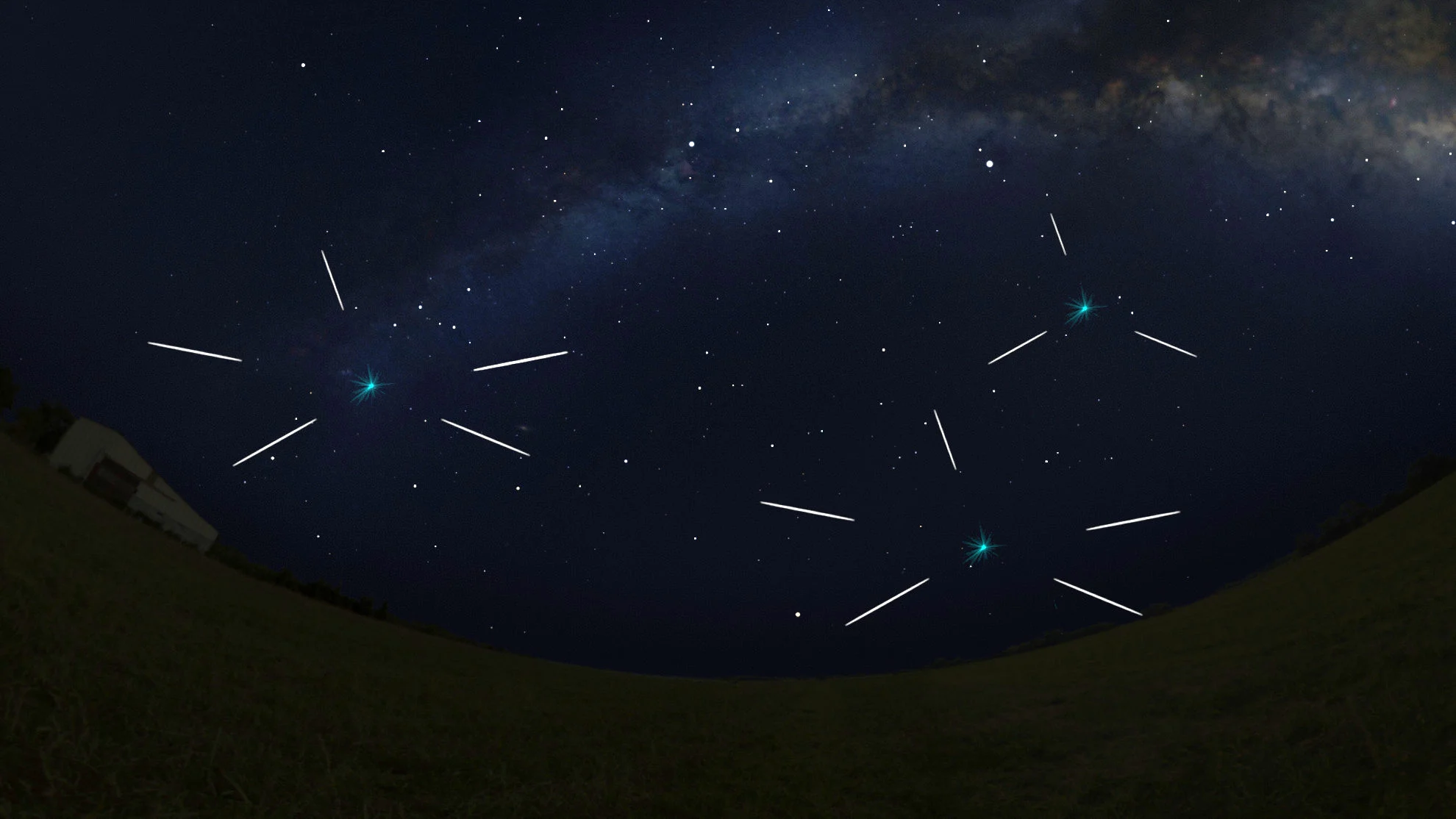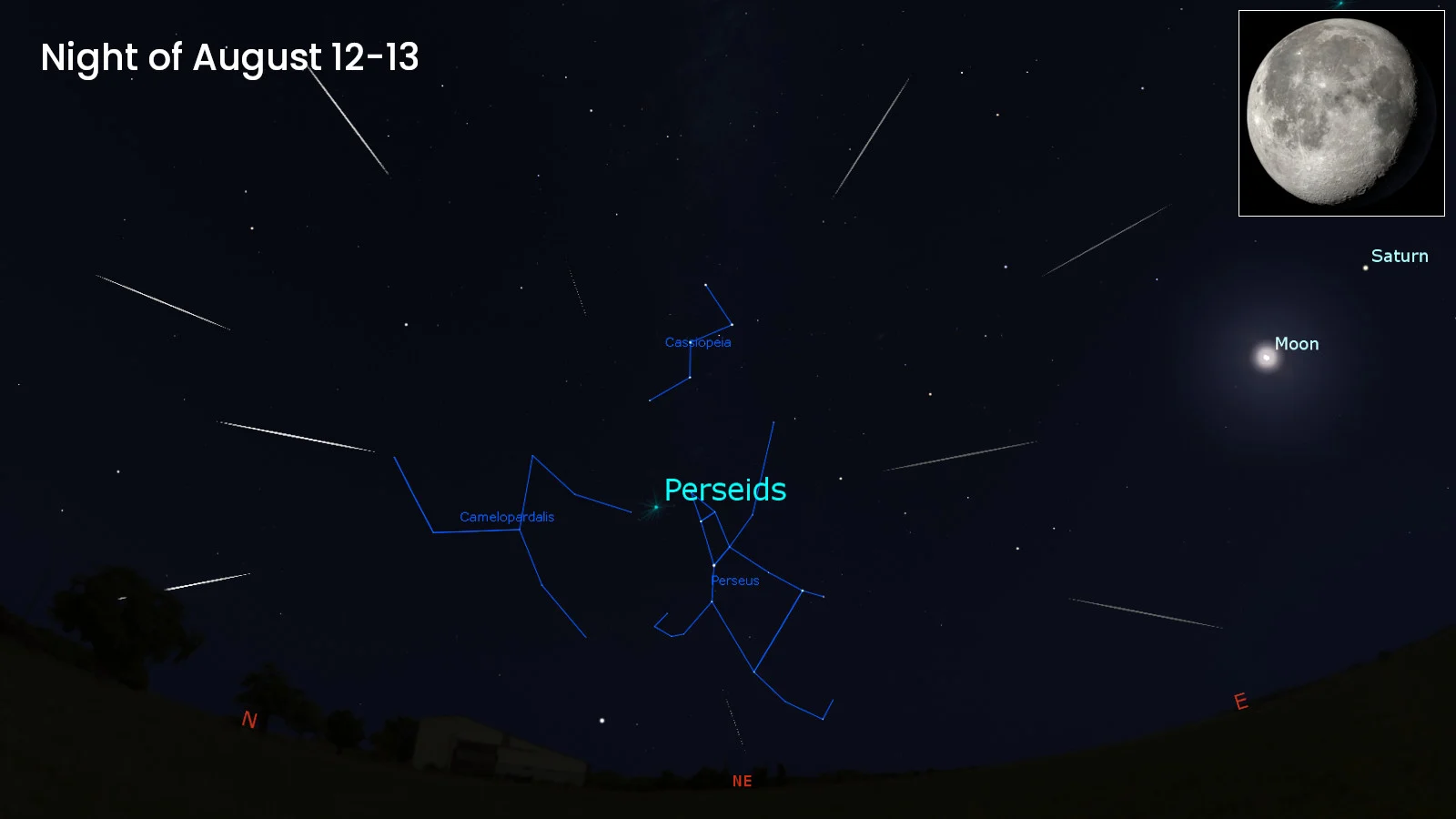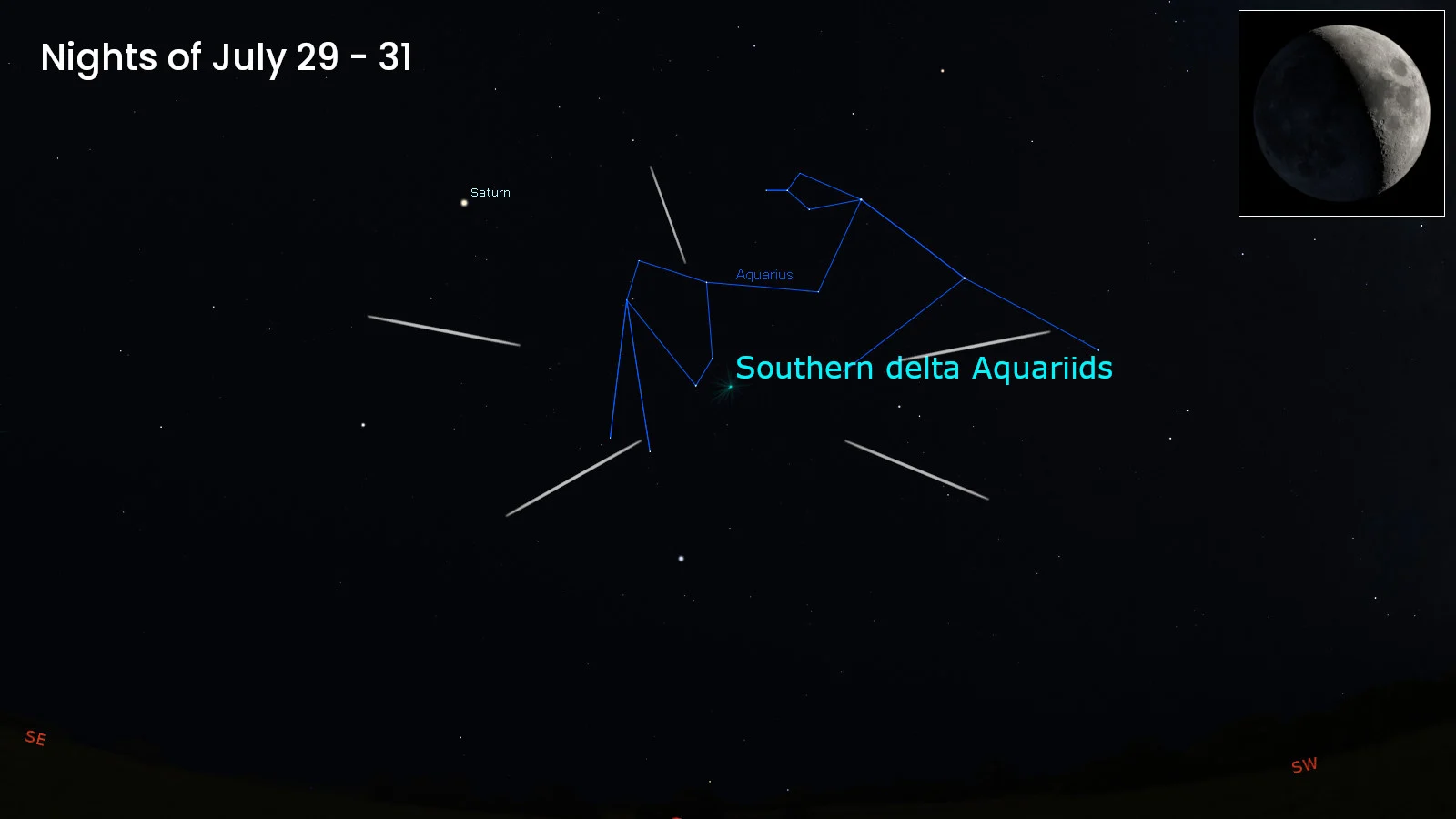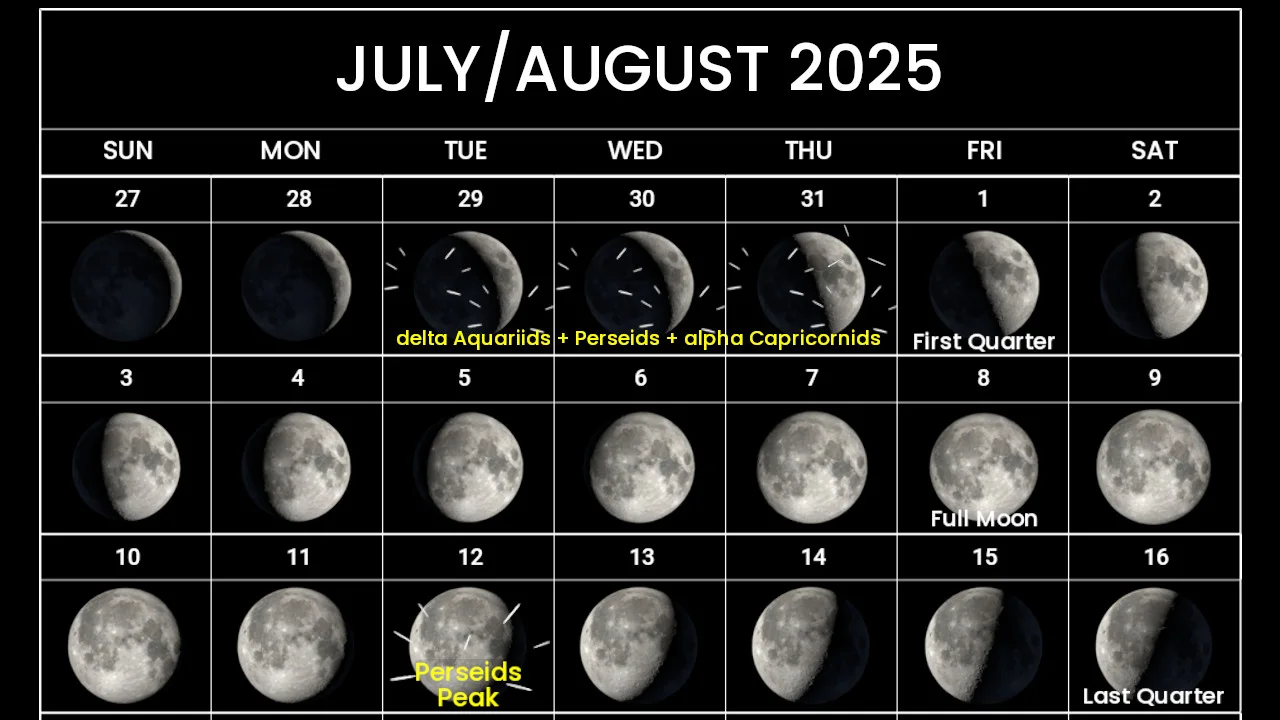
The meteor shower trio continues in our night skies
Keep looking up! The Perseids, delta Aquariids, and alpha Capricornids will continue their overlapping display for at least two more weeks!
What's better than one meteor shower? Three of them sending streaks of light across the night sky at the same time!
Each year, during the month of July, our planet Earth plunges into three separate streams of comet debris, each composed of ice and dust that orbits around the Sun. As we fly through these streams, the atmosphere sweeps up the tiny meteoroids directly in our path, which flash by overhead, producing a spectacular trio of overlapping meteor showers.
The first of these, the alpha Capricornids, originates from a comet known as 169P/NEAT. Although the meteor shower has been observed for a very long time, its parent body was not discovered until 2005. Originally thought to be an asteroid, further observations revealed weak comet activity when it neared the Sun.
We begin to see meteors from the alpha Capricornids in early July each year, radiating out from the constellation Capricornus, in the southern sky. This shower often goes unmentioned and unnoticed, though, as it produces just a handful of meteors each night from early July through mid-August.

The radiant of the alpha Capricornids, on the night of the meteor shower's peak, on July 31-August 1. The First Quarter Moon will be in the western sky, setting around midnight. (Scott Sutherland/Stellarium/NASA's Goddard Scientific Visualization Studio)
However, despite their rarity, alpha Capricornids tend to be fairly bright, and can even include a few fireballs — exceptionally bright meteors that are easily visible for hundreds of kilometres around on clear nights, even for observers trapped under heavily light-polluted skies.
The Perseids are the second of this trio to start. Originating from a comet called 109P/Swift–Tuttle, due to the angle of the meteoroids as they enter the atmosphere, the meteors appear from the direction of the constellation Perseus, in the northern sky.

The radiant of the Perseids (the point in the sky the shower appears to originate from) is located in the northeastern sky each night from mid-July through late August. The view in this simulation depicts the night of the peak, on August 12-13, 2025. The phase of the Moon (Waning Gibbous) is shown in the top right corner. (Simulation courtesy Stellarium. Moon phase from NASA's Goddard Scientific Visualization Studio)
The third is the Southern delta Aquariids. Although we don't know for sure, this shower appears to come from an oddball comet called 96P/Machholz. The odd thing about this object is that it's apparently unlike any other comet in our solar system, with a unique orbit and chemical composition. It's even possible that it's an alien comet that was long ago captured by our Sun's gravity as it wandered through interstellar space.
The meteors from Comet Machholz's debris stream can be traced back to the constellation Aquarius, in the southern sky. Also, due to the specific angle of the comet's path through the solar system, it produces a slightly better show in the southern hemisphere than the north. However, here in Canada, we can still see a decent number of meteors from it, if we know when to look.

The radiant of the delta Aquariids is located in the southern sky each night from mid-July through early August. The view in this simulation depicts the night of the peak, on July 30, 2025, although the delta Aquariids peak between the 29th and 31st. The July 30 phase of the Moon (Waxing Crescent) is shown in the top right corner. (Simulation courtesy Stellarium. Moon phase from NASA's Goddard Scientific Visualization Studio)
READ MORE: How to get the most out of meteor showers and other night sky events
All three of these meteors showers began slowly, producing just a few meteors at their start — the alpha Capricornids in early July, and the Perseids and delta Aquariids around the middle of the month.
The end of July was the best time to view the trio.
Based on their typical behaviour, by the last few nights of the month, around 20 Perseid meteors per hour would have been streaking out of the northeast, crisscrossing with about 20 delta Aquariids per hour from the southeast. On the night of the 31st, the alpha Capricornids would have added up to 5 more per hour to the overlapping display.
With the timing of the Moon's phases, the nights of the 29th, 30th, and 31st were the best time to go out and spot these meteors. This is because the Moon was off in the west throughout the evening and set by midnight. That left the rest of the night with a dark sky for picking out those brief flashes of light overhead.

This wider simulation of the eastern sky, on the night of July 31-August 1, 2025, shows the radiants of the Perseid, delta Aquariid, and alpha Capricornid meteor showers in their respective spots. The First Quarter Moon is setting on the western horizon at this time, out of view of the observer. (Scott Sutherland/Stellarium)
DON'T MISS: An alien comet is now passing through our solar system. Here's what we know
August Update
Now that we're into August, the number of Perseid meteors will continue to rise up until the night of the 12th. At the same time, the number of delta Aquariids and alpha Capricornids will ramp down significantly. Thus, total meteor numbers will remain fairly constant over the next week or so, but will more heavily favour the Perseids out of the northeast.
There's one caveat to this, though. During the first two weeks of August, the Moon will be casting off quite a bit of light as it passes through its brightest phases — Waxing Gibbous from the 2nd to the 7th, the Full Sturgeon Moon on the 8th-9th, and Waning Gibbous from the 9th to the 14th.

The phases of the Moon from July 27 through August 16 reveal why sky conditions may be best for this meteor shower trio at the end of July. (Scott Sutherland/NASA's Goddard Scientific Visualization Studio)
Having a dark sky is important for meteor watching, for two reasons: our eyes need to fully adapt to the dark to become sensitive enough to pick up the faintest flashes of light, and the contrast of the mostly-black background of space helps us in spotting the brief meteor streaks.
Bright moonlight acts in exactly the same way as urban light pollution, especially on humid summer nights, when the added water vapour in the air easily refracts that moonlight into our eyes. The sky becomes 'washed out', with only the brighest stars remaining visible, and similarly only the brighest meteors tend to be able to pierce that 'veil' of light.
Normally, as the Perseids reach their peak on the night of the 12th, observers under clear dark skies have a chance to spot up to 75-100 meteors every hour. This year, we will likely see closer to 40-50 per hour. Weather conditions could reduce that even further.
Fortunately, the Perseids are well-known for producing the greatest number of fireballs!
Watch below: Perseid fireball captured by NASA all-sky camera
After the peak of the Perseids, we can still spot meteors from the shower as it ramps down, right up until August 24. So, watch for clear skies in your forecast and keep an eye out for meteors and fireballs flashing through the night.
(Editor's note: This article has gone through a significant update to include additional information regarding the alpha Capricornids meteor shower and how it will add to the show produced by the Perseids and delta Aquariids.)
Thumbnail image produced using the open-source planetarium software, Stellarium.
